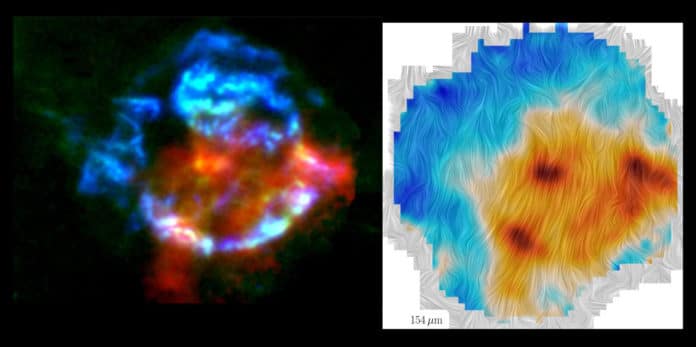Observations of local supernovae over the past couple of decades have detected the presence of dust in supernova ejecta. A new observation shows that the cosmic dust in the early Universe was formed in supernovae.
Infrared observations now suggest that the dust formed at an early stage of a supernova. SOFIA HAWC+ and D observations of the young supernova remnant (SNR) Cassiopeia A (Cas A) show high polarization at the 5-30% level. This is not random interstellar emission. This polarization indicates:
- Supernovae emit a tremendous amount of dust, and polarised dust emission detected in the far infrared belongs to the SNR.
- Instead of spherical, newly generated dust grains in supernovae are huge and elongated.
- The prevalent dust with such significant polarisation is silicate grains.
- In the early Universe, supernovae were key generators of dust.
Dr. Jeonghee Rho, a research scientist at the SETI Institute and the lead author of this research, said, “that the polarized dust emission belongs to the SNR Cas A. Studying far-infrared emissions is tricky since it is everywhere in the sky. Searching for emissions associated with supernovae is equivalent to finding a needle in the haystack. Polarization observations shine new light on that.”
Located in the constellation Cassiopeia, Cassiopeia A is a very young SNR 11,000 light-years away from Earth. Its light probably first reached Earth in or around 1671 AD. As a well-researched SNR, it also makes a great observation target. The HAWC+ from SOFIA is an imaging polarimeter and far-infrared camera that enables total and polarised flux imaging in five broad bands of wavelengths. At 154 microns, Cas A’s polarisation map was created (Band D).
Understanding the characteristics of dust grains can help scientists better understand the history of star formation and the evolution of the Universe. SOFIA’s polarization in Cas A, combining Spitzer and Herschel images, implies an estimate of a magnetic field of approximately 100 milli-Gauss. It puts Cas A as one of the strongest magnetic field sources. The grain alignment in supernova ejecta occurs with the magnetic fields, and dust polarization can reliably trace the magnetic field.
Scientists noted, “The observation showed that silicate dust grains are the dominant grains in Cas A. This result is meaningful because silicate dust’s survival rate is higher than other dust, so sufficient dust still exists behind the reverse shock. Other grains present could be iron-bearing dust, but additional wavelength observations or simulations will provide greater understanding.”
Deputy Director of SOFIA Science Mission Operations Bernhard Schulz said, “This work brings us closer to understanding processes in the early Universe leading to star and planet formation. By studying the grains more deeply with the James Webb Space Telescope, we hope to understand dust composition better.”
Journal Reference:
- Sarangi, A., Matsuura, M. & Micelotta, E.R. Dust in Supernovae and Supernova Remnants I: Formation Scenarios. Space Sci Rev 214, 63 (2018). DOI: 10.1007/s11214-018-0492-7
